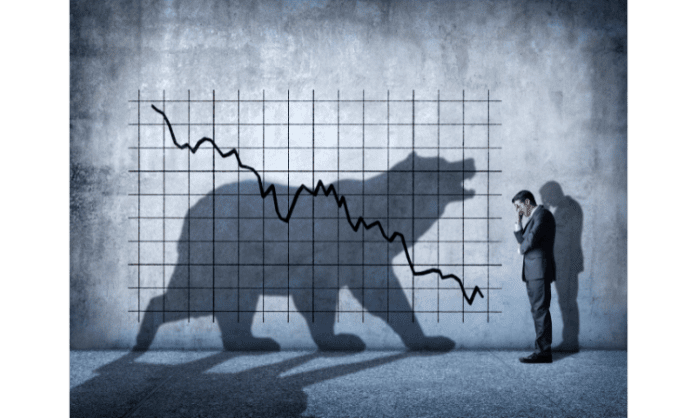
A bear market is a period of falling stock prices. Generally, if the S&P 500 has fallen 20% or more from a recent high and remains there for at least two months, it’s considered a bear market. These periods occur every few years as part of the normal business cycle, but they can be difficult to weather. The worst bear market in the US occurred during the Great Depression when stocks lost 89% of their value over three years. While the following tips won’t prevent a bear market from occurring, they may help you reduce their impact on your portfolio and make wise investment decisions during these periods:
What Is a Bear Market?

A bear market is a period of time when stock prices are falling. It’s a normal part of the market cycle and often follows bull markets, which are periods when stock prices rise. Bear markets aren’t the end of the world; they just mean stock values aren’t as high as they were before.
Check your goals and risk tolerance

Before you make any investment, it’s important to understand the risks involved. If you’re investing for retirement, you may have a long time horizon and can afford to take on more risk. If you’re investing for a short-term goal (like paying off student loans or buying a house), your time horizon is shorter and therefore your tolerance for risk should be as well.
Using these rules of thumb will help guide your decision-making when picking investments during a bear market.
Keep investing consistently

When the market is in a bear market, you want to keep investing consistently. You should not panic and sell everything because you think that it’s over for your investments. The best way to handle this situation is to invest on a regular basis whether the market is up or down.
Don’t try to time the market because there is no way of knowing when a bear will end and when it will begin again. If you have invested in an asset class with long-term potential, then do not worry about short term losses or gains as they are just part of the process.
Don’t be greedy when prices are high and don’t be afraid when prices fall sharply lower than expected; instead look at long term returns which should be positive over time because investments generally rise in value over time (on average).
Rebalance your portfolio

Rebalancing is a way to maintain a portfolio’s risk allocation and risk tolerance. By rebalancing your portfolio, you can help keep your risk in line with your own personal risk tolerance.
If you want to rebalance your portfolio, it’s best to do so at least once every six months or 12 months. This gives you enough time for some of the volatility of the market to subside and allows for any new money that has been added since last time around (or that may be added by investors) into accounts based on their performance history and past performance.
Adjust to falling share prices quickly

If you’re in your twenties and have a young family, you might be feeling the pressure to put money into shares. That’s because they’re seen as a good long-term investment that will give you a comfortable income when you retire. But if the market suddenly takes a dive, it can be hard for those with less experience to know what to do next.
The first step is to cut back on spending so that any investments can be used for day-to-day expenses instead of future security. This may mean making big changes such as selling your car or downsizing from an expensive house into something smaller and cheaper. In other cases though – especially if it’s already clear that your pension or mortgage won’t cover all of your basic costs – it may be better just not paying attention to anything else apart from getting food on the table!
Maintain perspective
Remembering your goals is important, but it can be easy to lose sight of them during a bear market. It’s important that you don’t panic and sell at the first sign of trouble. If something goes wrong with one penny stock, don’t sell all your stocks out of fear that they’ll become worthless too.
Likewise, don’t buy high and sell low—the opposite will only compound your losses in a bad market!
Don’t try to time the market: if you’re going to invest in stocks at all (which I strongly recommend), then it’s best not to try and time their ups and downs in any way whatsoever. You should always be invested in some sort of index fund or other broad portfolio; this will protect you from having too much or too little money tied up in any particular company while also giving you access to virtually unlimited investment options worldwide with just a single purchase!
Try value investing

There are many strategies for stock market investing.
One of the most popular strategies is called value investing, which involves buying stocks that are trading at a discount to their intrinsic value. In general, value investors will buy stocks when they think they can sell them later for more than they paid. The goal is to buy low and sell high.
Value investing works well in all types of economic environments: bear markets, bull markets, sideways markets—you name it! It’s a good strategy for any market condition because it’s based on fundamentals rather than emotions or other factors that might cause you to make unwise decisions while investing your hard-earned money (like jumping ship from one sector or industry too soon).
While bear markets can be frightening, they’re part of the normal market cycle.

It’s not uncommon to be frightened by a bear market, whether you’re a seasoned investor or just beginning your journey into the world of investing. If you’re new to the markets, it can be hard to know what to do during a bear market. However, there are some simple steps you can take that will help keep your portfolio safe and steady during this time:
- Stay focused on your long-term goals
- Don’t try to time the market
- Review all current holdings regularly
Conclusion
To sum up, bear markets are normal, and they can be a fantastic opportunity to buy shares at low prices. However, they’re also a time when many people panic and make mistakes. By staying calm, checking your risk tolerance and planning ahead, you can make the most of this downturn.











